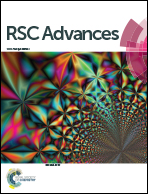Synthesis, characterization and biological evaluation of fused thiazolo[3,2-a]pyrimidine derivatives†
Abstract
A series of fused thiazolo[3,2-a]pyrimidines (7a–g, 8a–f, 11a–g and 12a,b) have been synthesized in good yields by reaction of fused 3,4-dihydropyrimidin-2(1H)-thiones (4a–g) with phenacyl bromides (5,6)/3-(2-bromoacetyl)coumarins (9,10) under conventional heating in acetic acid. Analytical and spectral studies as well as single crystal X-ray diffraction data on the representative compound 8e confirmed the structure of all the reaction products. All the synthesized compounds were screened for their antibacterial, antioxidant and DNA cleavage activities. The compound 7e against Escherichia coli, 8a and 8c–e against Pseudomonas aeruginosa have shown prominent antibacterial activity compared to the standard drug Penicillin with MIC 9.375 μg mL−1, whereas the compounds 11c, 12a and 12b have shown very good antioxidant activity compared to the standard drug Trolox with IC50 values 12.36, 11.12 and 13.88 μM respectively. Compounds 11f and 12b have completely cleaved the DNA even at 50 μg mL−1 concentration and the remaining compounds have partially cleaved the DNA.
![Graphical abstract: Synthesis, characterization and biological evaluation of fused thiazolo[3,2-a]pyrimidine derivatives](/en/Image/Get?imageInfo.ImageType=GA&imageInfo.ImageIdentifier.ManuscriptID=C4RA02514H&imageInfo.ImageIdentifier.Year=2014)

 Please wait while we load your content...
Please wait while we load your content...